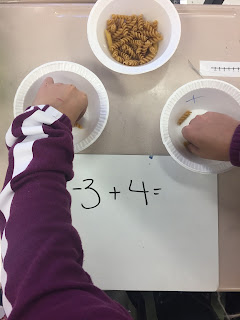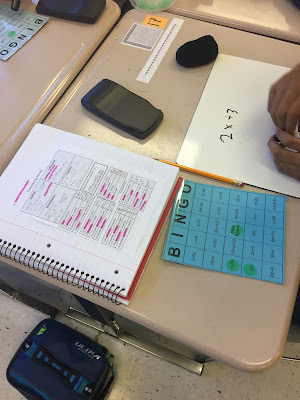I did.
It worked, for my strongest math students. Though, many of my students couldn't wrap their head around why - "Like terms, add, keep the sign. Unlike terms, subtract, keep the bigger number's sign"... It was more a process than understanding. We had modeled with dots, number lines, etc.
Then a few years back an ELL teacher had an idea about playing with pieces. That year we tried using little cut up squares of paper- different colors represented positive and negative. This worked- but wasn't the best.
Then came about PASTA!

Students put three pieces of pasta into the negative bowl and four pieces into the positive bowl. Matched up zero pairs and then saw how many they were left with. The tangible pieces of the pasta honestly made all the difference. It was incredible!
This is how it looked on my Active Board:


We play, we match positive and negative pasta to make zero pairs. We match until there are no more matches. We count, we observe where the pasta is left. IT MAKES SENSE! The kids then transfer that to what I call- a P/N Chart. We practice and slowly but surely we ween the chart away.
This chart as been incredibly successful for kids to relate the pasta bowls to. It has been an easy transition to discuss if they would be in the same pasta bowl or different pasta bowls. Here are two examples of how we solved problems using the charts. If they are different sides they decided how many would have matched and how many were left over. I definitely felt like a broken record quite often....
- How many match? (it is funny to hear the kids tell me there are no matches!!)
- How many are left over?
- Is it positive or negative? How do you know?

Soon they are truly making up their own rules! [teachers favorite moment ever!]
And- we don't do SUBTRACTING! I know this seems crazy! No more KFC (keep it, flip it, change it). It helps our students so much for them to realize that subtracting and negatives really mean the same thing (take away!). Which helps with the dreaded question of "Is this a negative or a subtraction sign???" I start by using circles around my problems to show them that a negative sign and a subtraction sign really is the same thing!


With problems that are double negatives, we conquer them as the English language does.
"She is not unhappy"-- what does that really mean? "She is happy"
Therefore:
As Integers is our first unit of the year in Math 7 it is a challenge to start with a unit that is often so difficult. However, students love all the manipulatives. Having students break things down themselves really does promote discovery and creation of rules on their own! Hope you can get something from this!
How have you taught adding integers?
Follow my blog with Bloglovin











